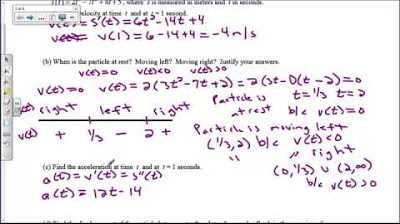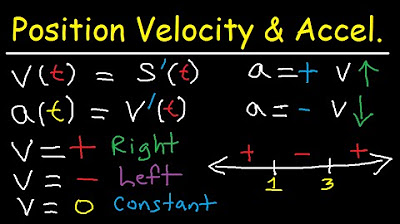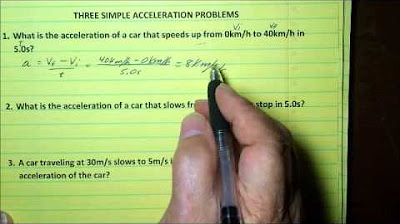Slowing Down Speeding Up Derivatives Application Calculus MCV4U
TLDRThis educational script explores the application of derivatives to determine an object's motion by analyzing its position, velocity, and acceleration. The position function \( s(t) = t^3 - 12t^2 + 36t \) is differentiated to find velocity and acceleration, with the object speeding up when both are positive or negative and slowing down when their signs differ. Through a detailed analysis, the script identifies intervals of speeding up (2 to 4 seconds and after 6 seconds) and slowing down (0 to 2 seconds and 4 to 6 seconds), offering a clear understanding of motion dynamics.
Takeaways
- 📚 The video discusses the application of derivatives to understand the motion of an object by linking position, velocity, and acceleration.
- 🔍 The position of the object is given by the function s(t) = t^3 - 12t^2 + 36t where t is time in seconds and s is position in meters.
- 🚀 An object is considered speeding up when both its velocity and acceleration are either both positive or both negative, indicating a consistent direction of motion.
- 🛑 Conversely, an object slows down when its velocity and acceleration have opposite signs, suggesting a deceleration in the direction of motion.
- 📉 Velocity is the first derivative of position, calculated as v(t) = 3t^2 - 20t + 36, and can be factored to 3(t - 6)(t - 2).
- 📈 Acceleration is the second derivative of position, found to be a(t) = 6t - 24, which factors to 6(t - 4).
- 📊 The object's velocity and acceleration must be analyzed at their zero points to determine intervals of speeding up and slowing down.
- 📌 Zero points for velocity occur at t = 2 and t = 6, indicating potential changes in motion direction.
- 🔎 Zero points for acceleration occur at t = 4, marking a transition point for the object's rate of change of velocity.
- 📋 By testing values within different intervals, the video concludes that the object speeds up between 2 to 4 seconds and after 6 seconds, and slows down between 0 to 2 seconds and 4 to 6 seconds.
- 📝 The analysis involves creating a table to compare the signs of velocity and acceleration across different time intervals to determine the object's motion state.
Q & A
What is the given position function of the object in terms of time?
-The position function of the object is given by \( s(t) = t^3 - 12t^2 + 36t \) where \( t \) is measured in seconds and \( s \) is in meters.
What does it mean for an object to be speeding up according to the script?
-An object is said to be speeding up when both its velocity and acceleration are either both positive or both negative, indicating an increase in the magnitude of velocity in the respective direction.
How is the velocity function derived from the position function?
-The velocity function is derived by taking the first derivative of the position function, resulting in \( v(t) = 3t^2 - 20t + 36 \).
What is the expression for the acceleration function after taking the second derivative of the position function?
-The acceleration function is obtained by taking the second derivative of the position function, which simplifies to \( a(t) = 6t - 24 \).
What are the critical points of the velocity function that indicate potential changes in the motion of the object?
-The critical points of the velocity function are at \( t = 2 \) and \( t = 6 \), where the velocity is zero, indicating potential turning points in the motion.
How can we determine the intervals where the object is speeding up or slowing down?
-By analyzing the signs of the velocity and acceleration functions over different intervals of time, we can determine whether the object is speeding up (same signs) or slowing down (opposite signs).
During which intervals is the object speeding up according to the analysis?
-The object is speeding up during the intervals from 2 to 4 seconds and from 6 seconds to infinity.
In which intervals is the object slowing down based on the script?
-The object is slowing down during the intervals from 0 to 2 seconds and from 4 to 6 seconds.
What is the significance of the zero points in the acceleration function?
-The zero point in the acceleration function at \( t = 4 \) indicates a change in the direction of acceleration, which can affect whether the object is speeding up or slowing down.
How does the direction of motion (positive or negative) affect the interpretation of velocity and acceleration?
-The direction of motion, indicated by the sign of velocity and acceleration, is crucial as it determines whether the object is moving in a positive direction (e.g., north) or a negative direction (e.g., south) and whether it is increasing or decreasing its speed in that direction.
What is the method used in the script to analyze the motion of the object over time?
-The method used involves taking derivatives of the position function to find the velocity and acceleration, factoring these derivatives to find critical points, and then analyzing the signs of these functions over different time intervals to determine when the object is speeding up or slowing down.
Outlines
📚 Application of Derivatives in Motion Analysis
This paragraph introduces the concepts of position, velocity, and acceleration in the context of derivatives. It explains how to determine if an object is speeding up or slowing down by analyzing the signs of velocity and acceleration. The position function s(t) = t^3 - 12t^2 + 36t is given, and the first step is to find the velocity by taking the first derivative. The conditions for speeding up are when both velocity and acceleration are either positive or negative, indicating a consistent direction of motion. The paragraph sets the stage for further analysis of the object's motion over time.
🔍 Deriving Velocity and Acceleration from Position
The paragraph delves into the mathematical process of finding the velocity and acceleration from the given position function. The first derivative of the position function yields the velocity, which is simplified and factored to find critical points where the velocity could be zero, indicating potential turning points. The second derivative provides the acceleration, which is also factored to understand its behavior over time. The paragraph discusses the intervals around these critical points to determine when the object is speeding up or slowing down, using test points to illustrate the direction of velocity and acceleration.
📉 Analyzing Motion Intervals for Speeding Up and Slowing Down
This paragraph concludes the analysis by examining the intervals of motion to determine when the object is speeding up or slowing down. The signs of velocity and acceleration are compared across different time intervals, with a focus on the behavior around the critical points identified earlier. The table created in the paragraph summarizes these intervals, showing that the object speeds up when both velocity and acceleration have the same sign (either both positive or both negative) and slows down when they have opposite signs. The final conclusion identifies the specific time intervals where the object is speeding up (from 2 to 4 seconds and after 6 seconds) and slowing down (from 0 to 2 seconds and from 4 to 6 seconds).
Mindmap
Keywords
💡Derivatives
💡Position
💡Velocity
💡Acceleration
💡Speeding Up
💡Slowing Down
💡Turning Point
💡Intervals
💡Direction
💡Factoring
💡Displacement
Highlights
Derivatives are applied to link position, velocity, and acceleration to understand when an object is speeding up or slowing down.
An object speeds up when both velocity and acceleration are either both positive or both negative.
Speeding up means increasing velocity magnitude in the direction of motion, whether it's north (positive) or south (negative).
Slowing down occurs when velocity and acceleration have opposite signs, like applying brakes while moving north.
The position function s(t) = t^3 - 12t^2 + 36t is given, with t in seconds and s in meters.
Velocity is the first derivative of position, v(t) = 3t^2 - 20t + 36.
Acceleration is the second derivative of position, a(t) = 6t - 24.
Velocity and acceleration are analyzed for intervals where they are positive or negative to determine speeding up or slowing down.
Zero points in velocity at t=2 and t=6 indicate potential turning points in the motion.
Test points are used to determine the sign of velocity and acceleration in different intervals.
Velocity is positive from 0 to 2 seconds and after 6 seconds, indicating motion in the positive direction.
Acceleration is negative before t=4 and positive after, showing a change from slowing down to speeding up.
A table is constructed to combine velocity and acceleration signs to determine intervals of speeding up and slowing down.
The object is found to be speeding up during the intervals 2 to 4 seconds and after 6 seconds.
The object is slowing down during the intervals 0 to 2 seconds and 4 to 6 seconds.
The analysis concludes with a clear summary of when the object speeds up and slows down based on the signs of velocity and acceleration.
Transcripts
Browse More Related Video

Motion problems: when a particle is speeding up | AP Calculus AB | Khan Academy

Particle Motion - Speeding Up and Slowing Down (Example, AP Calculus)

Particle MotionDay1

2023 AP Calculus AB FRQ #2

Calculus - Position Average Velocity Acceleration - Distance & Displacement - Derivatives & Limits

Solving Three Acceleration Problems
5.0 / 5 (0 votes)
Thanks for rating: